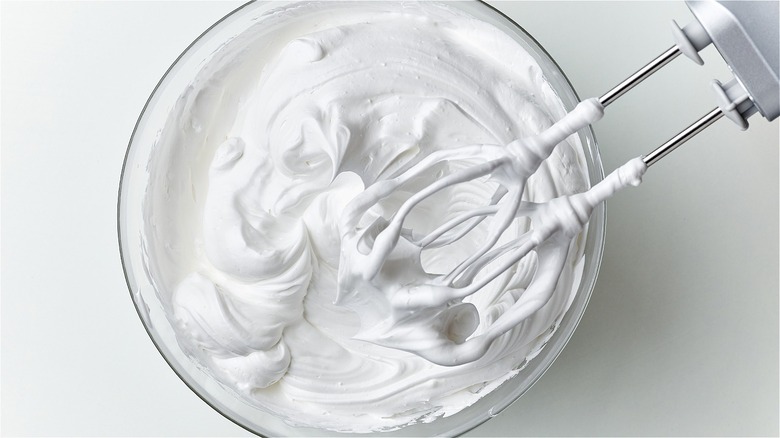This Might Be The Easiest Way To Fix Over-Whipped Cream
Whether you're putting a dollop on a steaming mug of hot chocolate or using it to top a slice of pie, there's nothing as simple and decadent as freshly whipped cream. Sure, you can always use the store-bought version in the aerosol can, but if you have a few minutes, making your own whipped cream yields results that taste just that little bit better. And while ChefWorks acknowledges there are a few common mistakes that you might make, it's a relatively simple process.
While once upon a time whipping cream by hand was quite an ordeal, nowadays many home cooks have a mixer that allows them to easily transform cream into pillowy, soft, airy clouds that can top a variety of culinary creations. There's just one problem with this — since your mixer is whirring away in the background, you're no longer keeping an eye on how the whipped cream is progressing as you would while whipping by hand. This means if you step away for a little too long to tend to another part of your meal, or simply do something else in your home, you might end up with over-whipped cream. The grainy texture and lumpy consistency that over-whipped cream has is definitely not ideal.
If you've always just thrown out over-whipped batches, here's a useful tip to have in your arsenal that allows you to easily bring your over-whipped cream back to the perfect consistency so that you don't have to start from scratch again.
Grab a bit of extra cream
To rescue your whipped cream, you don't need any unusual ingredients. Instead, as The Kitchn explains, you just need some more of the cream you started with. This tip might also encourage you to buy a little more cream than you need, just in case things go awry — plus, it's never a bad thing to have a bit of leftover whipped cream in your fridge for an impromptu dessert or drink topping.
With the fresh cream in hand, all you do is start to drizzle or slowly add small amounts into your over-whipped batch of cream, little by little, until you have the correct consistency. If every ounce of cream you have is already in the bowl, Good Housekeeping suggests that regular cold milk can actually help to achieve the same goal.
Besides making sure to keep an eye on your cream as it's whipping, there are a few other things you can do to ensure perfectly whipped cream, every time. As ChefWorks explains, you always want to start with chilled cream. Warm or room-temperature cream just won't whip the same way and won't get that same texture. You also want to make sure you've purchased cream with a high enough fat content — according to Fine Cooking, you typically need a minimum of 30% fat. And finally, always add sweetener at the right time, once you have soft peaks — if you add it too early, it can actually stop the cream from properly thickening.

